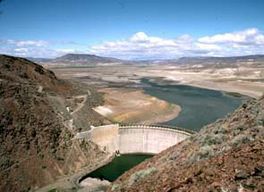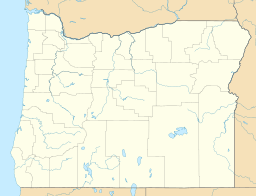Warm Springs Reservoir facts for kids
Quick facts for kids Warm Springs Reservoir |
|
|---|---|

Warm Springs Dam and Reservoir
|
|
| Location | Harney / Malheur counties, Oregon, United States |
| Coordinates | 43°35′08″N 118°12′32″W / 43.58556°N 118.20889°W |
| Type | Reservoir |
| Primary inflows | Malheur River |
| Primary outflows | Malheur River |
| Catchment area | 1,059.5 sq mi (2,744.1 km2) |
| Basin countries | United States |
| Built | 1919 |
| Max. length | 8.5 mi (14 km) |
| Max. width | 1.3 mi (2.1 km) |
| Surface area | 4,194 acres (1,697 ha) |
| Average depth | 68 ft (21 m) |
| Max. depth | 140 ft (42.7 m) |
| Water volume | 169,714 acre⋅ft (209,339 dam3) |
| Residence time | 2.2 years |
| Shore length1 | 34.5 mi (55.5 km) |
| Surface elevation | 3,406 ft (1,038 m) |
| 1 Shore length is not a well-defined measure. | |
The Warm Springs Reservoir is a large, human-made lake in Oregon, United States. It sits right on the border between Harney and Malheur counties. This reservoir is about 13 miles (21 km) southwest of a town called Juntura. It is located at an elevation of 3,406 feet (1,038 m) above sea level. The main river that flows into and out of the reservoir is the Malheur River.
Contents
Building the Warm Springs Dam
The Warm Springs Reservoir was created by building the Warm Springs Dam. This dam is made of concrete and is 106-foot (32.3 m) tall and 469-foot (143 m) long. It's a special kind of dam called a "thin-arch" dam.
Dam Construction History
The Warm Springs Dam was built a long time ago, between 1918 and 1919. The Warm Springs Irrigation District was in charge of building it. Later, in 1930 and 1939, the dam was updated and improved. The United States Bureau of Reclamation helped with these changes. The dam was built using 19,500 cubic yards (14,900 m3) of material. It sits on top of layers of olivine basalt lava, which are types of volcanic rock.
About the Reservoir
The Warm Springs Reservoir is quite big. It stretches about 8.5-mile (14 km) long and 1.3-mile (2.1 km) wide.
Reservoir Size and Depth
At its largest, the reservoir covers an area of 4,194 acres (1,697 ha). It can hold a huge amount of water, up to 169,714 acre-feet (209,339 dam3). The deepest part of the reservoir is about 140 feet (42.7 m) deep. The edge of the reservoir, called the shoreline, is about 34.5 miles (55.5 km) long. It takes about 2.2 years for all the water in the reservoir to be completely replaced by new water flowing in. This is called its residence time.
The Surrounding Area
The area that collects water for the Warm Springs Reservoir is called its watershed. This watershed covers a large part of eastern Oregon, about 1,059.5 square miles (2,744.1 km2).
Weather and Population
On average, the watershed gets about 17.5 inches (444 mm) of rain each year. In the year 2000, about 157 people lived within this watershed area.
Wildlife in and Around the Reservoir
The Warm Springs Reservoir and its surrounding areas are home to various animals.
Animals on Land and in Water
The most common large animals you might see are mule deer. Many different kinds of waterfowl, which are birds that live near water, also live here. In the reservoir itself, you can find several types of fish. These include bass, bluegill, and rainbow trout.
Water Quality
The reservoir's water is described as eutrophic. This means it has a lot of nutrients, which can sometimes lead to too much plant growth. The water's clarity, measured by something called a Secchi disk, is about 3.3 feet (1.0 m). This measurement tells you how far you can see down into the water.



